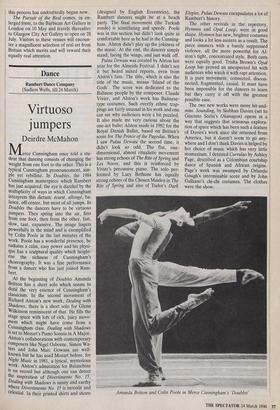Dance
Rambert Dance Company (Sadlers Wells, till 24 March)
Virtuoso jumpers
Deirdre McMahon
Merce Cunningham once told a stu- dent that dancing consists of changing the weight from one foot to the other. This is a typical Cunningham pronouncement, sim- ple yet sybilline. In Doubles, the 1984 Cunningham masterpiece which Rambert has just acquired, the eye is dazzled by the multiplicity of ways in which Cunningham interprets this dictum: ecarte, allonge, ba- lance, off-centre, but most of all jumps. In Doubles the dancers have to be virtuoso jumpers. They spring into the air, first from one foot, then from the other, fast, slow, taut, expansive. The image lingers Powerfully in the mind and is exemplified by Colin Poole in the last minutes of the work. Poole has a wonderful presence, he radiates a calm, easy power and his physi- que has a sculptural quality which height- ens the richness of Cunningham's choreography. It was a fine performance from a dancer who has just joined Ram- bert.
At the beginning of Doubles Amanda Britton has a short solo which seems to distil the very essence of Cunningham's classicism. In the second movement of Richard Alston's new work, Dealing with Shadows, there is a short solo for Glenn Wilkinson reminiscent of that. He fills the stage space with lois of rich, juicy move- ment which might have come from a Cunningham class. Dealing with Shadows is set to Mozart's Piano Sonata in A Major. Alston's collaborations with contemporary Composers like Nigel Osborne, Simon Wa- ters and John Marc Gowans are well- known but he has used Mozart before, for Night Music in 1981, a lyrical, mysterious work. Alston's admiration for Balanchine is on record but although one can detect the inspiration of Divertimento No. 15, Dealing with Shadows is sunny and earthy where Divertimento No. 15 is moonlit and celestial. In their printed shirts and shorts (designed by English Eccentrics), the Rambert dancers might be at a beach party. The final movement (the Turkish rondo) is scintillating and speedy. Poole was in this section but didn't look quite as comfortable here as he had in the Cunning- ham. Alston didn't play up the jokiness of the music. At the end, the dancers simply stand, facing the wings, and just walk off.
Pulau Dewata was created by Alston last year for the Almeida Festival. I didn't see it but heard mixed reports, even from Alston's fans. The title, which is also the title of the music, means 'Island of the Gods'. The score was dedicated to the Balinese people by the composer, Claude Vivier, and Alston's work has Balinese- type costumes. Such overtly ethnic trap- pings are fairly unusual in his work and one can see why audiences were a bit puzzled. It also made me very curious about the one-act ballet Alston made in 1982 for the Royal Danish Ballet, based on Britten's score for The Prince of the Pagodas. When I saw Pulau Dewata the second time, it didn't look so odd. The flat, one- dimensional, almost ritualistic movement has strong echoes of The Rite of Spring and Les Noces, and this is reinforced by Vivier's percussive piano. The solo per- formed by Lucy Bethune has equally strong echoes of the Chosen Maiden in The Rite of Spring and also of Tudor's Dark Elegies. Pulau Dewata encapsulates a lot of Rambert's history.
The other revivals in the repertory, Hymnos and Opal Loop, were in good shape. Hymnos has new, brighter costumes and looks a lot less austere as a result. The piece simmers with a barely suppressed violence, all the more powerful for Al. ston's tight, concentrated style. Both casts were equally good. Trisha Brown's Opal Loop has proved an unexpected hit with audiences who watch it with rapt attention. It is pure movement, connected, discon- nected, fragmented, casual. It must have been impossible for the dancers to learn but they carry it off with the greatest possible ease.
The two new works were more hit-and- miss. Sounding, by Siobhan Davies (set to Giacinto Scelsi's Okanagon) opens in a way that suggests that sensuous explora- tion of space which has been such a feature of Davies's work since she returned from America, but it doesn't seem to go any- where and I don't think Davies is helped by her choice of music which has very little momentum. I detested Currulao by Ashley Page, described as a Colombian courtship dance of Spanish and African origins. Page's work was swamped by Orlando Gough's interminable score and by John Galliano's chi-chi costumes. The clothes were the show.
Amanda Britton and Colin Poole in Merce Cunningham's 'Doubles'


















































 Previous page
Previous page